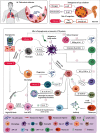Cellular Immunity of Patients with Tuberculosis Combined with Diabetes
- PMID: 35692502
- PMCID: PMC9177301
- DOI: 10.1155/2022/6837745
Cellular Immunity of Patients with Tuberculosis Combined with Diabetes
Abstract
Tuberculosis (TB) is one of humanity's three major infectious diseases. Diabetes mellitus (DM) is a metabolic disease characterized by hyperglycemia due to impaired insulin secretion or impaired insulin function. It has been reported that DM is a primary risk factor for TB disease. Given the increasing public health threat to people's health, more and more studies have focused on diabetes complicated by TB. Hyperglycemia can affect the function of human immune cells, promote primary infections and reactivation of TB, and increase the susceptibility and severity of TB. However, the immunological mechanism behind it is still not clear. By reviewing the related articles on tuberculosis complicated with diabetes published in recent years, this paper expounds on the effect of hyperglycemia on innate immunity and adaptive immunity of patients with TB. This review provides new insights for elucidating the immunological mechanism of TB complicated with DM and lays the foundation for finding potential targets for preventing and treating TB combined with DM.
Copyright © 2022 Peng Cheng et al.
Conflict of interest statement
The authors declare no conflict of interest.
Figures


References
-
- WHO. Global Tuberculosis Report . Vol. 2021. Geneva: Genevapp: World Health Organization; 2021.
-
- Saeedi P., Petersohn I., Salpea P., et al. Global and regional diabetes prevalence estimates for 2019 and projections for 2030 and 2045: results from the International Diabetes Federation Diabetes Atlas, 9th edition. Diabetes research and clinical practice . 2019;157:p. 107843. doi: 10.1016/j.diabres.2019.107843. - DOI - PubMed
Publication types
MeSH terms
LinkOut - more resources
Full Text Sources
Medical

